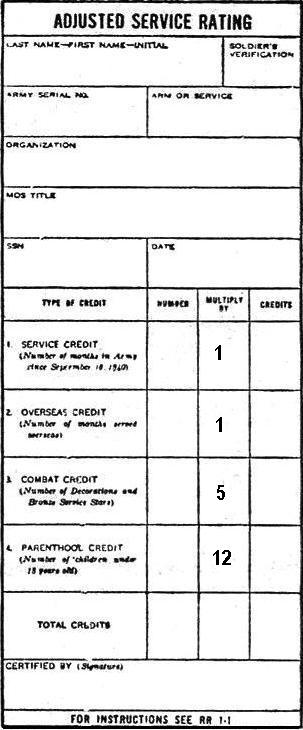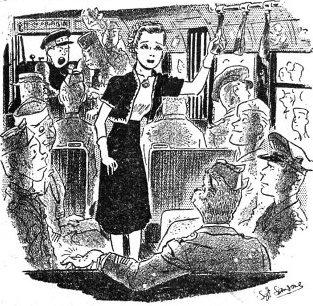
|
Flying Tiger Fighters, Bombers Pound Japs At Paoching; Lash Indo-China Troops, Rails HQ., 14TH AIR FORCE - Intensification of Fourteenth Air Force strikes against key Japanese facilities on the Shensi-Honan and Hunan fronts in China during the week, May 7 through May 13, was highlighted with the destruction, on May 9, of Paoching funnel for enemy troops and supplies concentrated for the now stalled drive against the American forward base at Chihkiang. With no air opposition encountered throughout the week, Mitchells, Mustangs, Sharks and Liberators of
In north and central China, operations were concentrated against storage dumps, railroad networks, inland waterways and troops pocketed by Chinese ground forces, as well as immense oil and gasoline tank terms at Tangku, seaport of Tientsin. Striking forces in south China and French Indo-China hammered enemy communications facilities and destroyed hundreds of troops and rolling stock. The razing of Paoching, on the Tzu River, marked what may develop into the turning point of ground warfare on the Chihkiang front as the Fourteenth striking force set the city ablaze, then concentrated on destruction of highway networks leading from the doomed Jap supply and troop center to the threatened American base. Pounded by nearly 100 Fourteenth Air Force bombers and fighters, Paoching was destroyed as the strikers dumped more than one hundred tons of bombs, one fourth of them concentrated fire bombs which transformed the community of 138 acres and a normal population of 100,000 into a sea of flames and sent smoke billowing up to 8,000 feet. First struck by Liberators, the enemy supply reinforcement funnel for the Chihkiang front was hammered into complete uselessness by following waves of medium bombers and fighters. With destruction of the city completed, aircraft continued to blast arterial highways leading to Chihkiang. To begin the week, Fourteenth striking forces on May 7 supported Chinese ground forces on the Shensi-Honan-Hunan fronts by striking and bombing enemy troop concentrations in the Laohokow sector. Enemy ammunition and storage dumps were strafed by low-flying Mustangs, Sharks and Thunderbolts. West of Hsihsiassucht, near the confluence of the Tan and Han rivers. Sharks hit Jap tank and truck columns, as well as enemy headquarters and warehouses in the area. The Fourteenth celebrated V-E Day on May 8 with strikes which ranged from the Peiping area to the French Indo-China coast. At Taku, seaport of Tientsin, Mustangs fired tank farms with direct hits on storage facilities aggregating a capacity of nearly twenty million gallons. The tank farms were a mass of flames from which smoke spouted to 8,000 feet when the fighters turned to enemy shipping, setting ablaze two each 350-foot steam cargo vessels, two tugs and two smaller boats, and damaged a 500-foot freighter, a river boat and a 75-foot tug. In support of Chinese Ground Forces on the Yellow River - Han-Tan front, Thunderbolts and Mustangs on May 8 struck Loning, in the Hsihsiassuchi area and south of Laohokow, fire bombing enemy troop concentrations in villages and along highways, and firing gasoline dumps. Sharks continued their strikes against Japanese troops, tanks and artillery positions in that sector. Operation in French Indo-China were centered against enemy troop movements on the coastal railways and in border areas. Mustangs and Mitchells which swept the railroad line destroyed eight locomotives and damaged seven, then broke bridges and destroyed highway traffic and rolling stock. Trapped aboard flatcars on a ferry and at a river crossing, Japanese reinforcements were strafed by Mustangs in eight passes which left unestimated casualties among the packed troops. In addition to blasting Paoching out of existence as a military installation, coordinated missions of Fourteenth bombers and fighters on May 8 and 9 hit 21 locomotives and large amounts of rolling stock in sweeps along the Pingsan, Tung Pu, Lung Hai and Chengtai railroads on both the Sensi-Honan and Hunan fronts. The strikes also nullified Japanese positions southwest of Loning, with Chinese Ground Forces taking the installations immediately after the air attack. In this sector, operations knocked-out bridges and killed hundreds of enemy troops. The tempo of the aerial war against Jap concentrations on the Hunan front was stepped up as fighters pounded enemy lines deep in the Paima Shah hills sector, where Chinese Ground Forces were given concentrated air support.
In north China, ten locomotives on the Tung Pu and Ping-Han railroad were damaged on May 10 as fighter operations hit bridges, trackage and supply concentrations. Continued support was given Chinese troops as pockets of Japanese were hammered into submission. The days operations again included attacks against French Indo-China communications systems. Enemy casualties continued to run high on the Hunan front on May 11 when Jap forces, flanked or surrounded by Chinese troops, were strafed and bombed. In the Tungkow-Shanmen sector, Sharks blasted a sealed-off pocket of 1,000 troops and horses with unestimated casualties. When Mustangs operations hit the same target, the Japs, caught in the open, attempted a ruse by waving greetings. Not deceived after the first pass, the Mustangs returned and Chinese troops reported many enemy dead after the attack. On the same day at Yiyang on the south shores of Tungting Lake, Sharks left a two-deck steamer in flames, damaged seven each, 150-foot lake boats and four each 75-foot single-deck power boats. Jap troop and artillery positions in the Paima Shah and Yangchi areas again were knocked-out by Mustangs and Sharks. Throughout May 12 and 13, operations in the Yellow River sector were concentrated against the Yellow River railroad network. Seventeen locomotives were damaged and the crumbling Jap supply lines were further crippled as trackage, bridges and anti-aircraft positions were hit by medium bombers and fighters. On May 12, Mustangs made repeated passes at a loaded Japanese convoy which was caught on the road 20 miles north of Changsha. This strike set off secondary explosions, observed when the fighters were ten miles from the target and indicating that ammunition stocks had been hit, destroying trucks, carts, horses and troops which made up the convoy. Further minimizing Japanese air power in China, strafing Mustangs hit the Pailuchi airdrome on the Hunan front May 12, further damaging twin-engined and single-engine enemy aircraft which were under repair. |
GAIN CONTROL ON
HUNAN FRONT
HQ., CHINESE COMBAT COMMAND, KUNMING - An American colonel, whose name cannot be divulged, has just returned to a rear area from the Hunan front with a graphic eyewitness account of conditions there.
According to his observations, Chinese ground forces, working in very close coordination with the hard-hitting Fourteenth Air Force, have administered a defeat to the Japanese attackers, and have probably thwarted, at least for the time being, what once looked like a very dangerous and imminent Japanese threat to the 14th Air Force base at Chihchiang.
"One of the best indications that the threat has at least temporarily subsided," he says, "is that Chinese villagers and peasants who had fled westward in long lines during the early stages of the Jap advance are now trickling back to their homes in increasing numbers. When the reserved, practical Chinese peasant decides the danger is past for the time being, it usually is."
Civilians returning eastward to their homes in Huna around the Chinese defense perimeter of Chihchiang are a fairly steady trickle now, though not in sufficient numbers to interfere with Chinese military traffic, the observer states. Most residents are returning home with their household effects suspended from sticks across their shoulders; however, they also use wheelbarrows and carts where the few roads permit.
The colonel, speaking entirely unofficially, personally attributes the marked Chinese successes of the past months to the aggressive combat spirit and fighting morale exhibited by Chinese Army elements and to the close and effective coordination of air and ground attacks. During the month the Chinese halted the Japanese attempt to advance all along the 125 kilometer Hsinhwa-Hsinning front and then went over to the counter-offensive in many important sectors.
"The air functions as artillery," the officer states. "Whether it is a matter of breaking up a Japanese push or paving the way for a Chinese counter-thrust, they work together. American air-ground liaison teams with the Chinese were in constant radio communication with the air bases and with planes in the air. Whenever and wherever the Japs concentrate, planes are immediately sent for simultaneously, while the Japs are catching hell from the air, the Chinese ground forces open up with ground fire. Then, while the enemy is still groggy, the Chinese infantry moves in and handles the situation at short range."
The hand grenade, the colonel says, is the favorite weapon of the Chinese infantry on the Hunan front, and they are using it extensively and effectively to cause heavy casualties. "At one spot on the front," he says, "I stood with my feet together and counted 16 Jap bodies immediately within range of my vision. Apparently most of these were victims of Chinese hand grenades."
Heavy casualties caused by air strikes were also reported, ranging from 100 to 200 dead Japanese in certain areas hit by the air arm.
The area in which the fighting is taking place, the colonel points out, is one in which topography and weather combine to make large scale operations extremely complicated and difficult. The country, he says, is not just hilly - it is mountainous, with rugged peaks interlaced by deep gulleys, ravines and valleys, heavily wooded. Trails are few and tortuous, and even the main roads wind up and down such steep grades and around such sharp and frequent curves that rapid travel is difficult. In many areas, elements only 15 miles apart by air may be separated by several days hard travel on the ground.
"The Japanese have been up to their old infiltration tactics on this fluid front, but in many cases their tactics have backfired because of the fighting spirit of the Chinese," this officer observes. "Many times when Chinese elements at daylight discovered that Japanese had infiltrated into their rear during the night, the Chinese refused to give way to panic and turned the tables by stubbornly wiping out the enemy pockets, sometimes at high cost to the Chinese. At the same time, the Chinese are proving that two can play at the same game by the use of successful infiltration tactics of their own."
Summing up the overall Hunan situation, the colonel believes that the Japanese, contrary to their initial expectations, have found the road to Chihchiang too costly in casualties and too difficult to supply to make possible the present attainment of their objectives.
Paoching Success May Open Way For Massacre Of Japs
By CLYDE A. FARNSWORTH
CHIHKIANG, May 17 (AP) - The blotting out of Paoching, the staging center for the now miscarried Japanese offensive in western Hunan, may open up the way toward the massacre of the whole enemy force in the mountains to the west.
&The Japanese front forces were already running low on ammunition before Paoching was blasted, it is reported. Examination of the enemy dead indicated that the Japanese soldiers were left to defend some difficult positions

|
The destruction of Paoching followed only after repeated efforts, through pamphlets, to warn the Chinese civilian population of the danger of remaining there, and very few, if any, civilians were likely there when the 14th AF delivered one of its heaviest strikes of this war.
The Japanese offensive force, originally estimated at between 20 and 25 thousand, is already being sliced into segments by the valiant Chinese counter-drives, and the reduction of these segments one by one may be expected.
Indeed, the way may be cleared for an eventual Chinese grand offensive against the Japanese supply corridor running through southeast China into southeast Asia. The close collaboration between the Chinese and the Americans both in the air and on the ground is now paying off in one of the most dramatic turns of the war in China.
It remains to be seen whether the Japanese already withdrawn in bulk from Burma, will attempt to pull back into China from Malaya, Thailand and French Indo-China for a knock-down and drag-out fight.
The million Japanese troops now spread over China and retreating from southeast Asia might, if any degree successful, alter the military situation in China somewhat in the enemy's favor. But if their supplies are cut off China may be turned into a vast slaughter ground.
It is apparent even now that the supply show is pinching the other foot - that's the Japanese foot - in China. The sea lanes to southeast China and southeast Asia have already been denied the enemy and their land communications are being subjected to increasing assault by air.
24 CCC Troops Go Stateside Under New WD Point System
HQ., CHINESE COMBAT COMMAND, KUNMING - (Special to The China Lantern) - The first shipment of 24 Chinese Combat Command personnel are now on their way to the United States under the War Department point system plan for readjustment of military personnel after the defeat of Germany. A shipment including 23 enlisted men and one officer departed from this headquarters late Tuesday.
Included in the first shipment to the States under this widely-talked-about readjustment system were 17 regular Army men, 3 Selective Service men, 2 from the National Guard, one from enlisted reserve and one from Officer Reserve Corps.
Average Army service for the entire first shipment was 68 months, or well above the maximum of 56 months total service months that are allowable for credits under the point system. Lengths of service for the group
|
Other personnel will be shipped to the States under the Army readjustment plan as rapidly as conditions permit, though not all eligibles wish to go before the war is over. One headquarters in Chinese Combat Command had 8 men eligible under existing directives to return to the United States, but three had at the latest report declined the privilege and only 5 are going to take the Army up on its offer at this time. Under existing directives, on headquarters estimates, an average of 40 persons per 1,00 are eligible for return to the States. The number who may desire to remain in China is unknown and unestimated.
Chinese Combat Command's first shipment of personnel who left Tuesday evening under the readjustment point plan were these 24:
Lt. Col. John A. Svendagaard, San Leandro, Calif.,; M/Sgts. Russel B. Halliday, Pittsburg, Pa; Anthony V. Pasini, Richmond Hill, N.Y.; T/Sgts. William D. Royce, White lake, Wis.; Gordon A. Craig, Carthage, Mo.; Frank J. Czech, Jr., Mirando City, Tex.; Wallace G. Heath, Amarillo, Tex.; S/Sgts. Ingram A. Smith, Savannah, Ga.; James J. Malson, Fayetteville N.C.; Robert H. Anderson, Highland Falls, N.Y.; Denby Mullis, Chapel Hill, N.C.; Frank E. Kers, Hayward, Cal.; Sgts. Hillard Hall, Jr., Wheelright, Ky.; John J. Mazack, Shenandoah, Pa.; William B. Donovan, New York City; T/4 Lyman L. Witmer, Pine Grove, Pa.; T/5s Francis Armond, Gillet, Wis.; Roland E. Rough, Nescopeck, Pa.; Luke Frina, Brownsville, Tex.; Pfcs. Richard L. Ashley, Petty, Tex.; William H. Davidson, Jr., Bristol, Tenn.; Sigmund C. Knapp, Chicago, Ill.; Pvts. Carl J. Everett, Montgomery, la. and Lee Ridner, Stearns, Ky.
Sultan Commends Chinese Soldiers
CHINESE TRAINING CENTER, YUNNAN PROVINCE - Lt. Gen. Dan I. Sultan, commanding the India-Burma Theater, paid high compliment to the fighting qualities of the Chinese who fought under him in the Burma campaign, on the occasion of a recent visit he paid to headquarters of the Chinese Training Center.
Addressing officer students of the Command and General Staff School, one of the U.S. Army schools operating under the Chinese Training Center, Gen. Sultan said:
"The Chinese troops who have served under me, particularly those who fought through the campaign in Burma, were as good soldiers as any commander could want. I'm very proud of them but the Chinese armies and there staffs would have been even better if the officers had had the opportunity to attend such a fine school as this one.
"The Command and General Staff School in China has a schedule of studies very like that of the Command and General Staff School of the U.S. Army at Ft. Leavenworth. As a result of attending this school I am sure that your efficiency and ability to serve effectively in your commands will be greatly increased.
"I think you are very lucky to have the opportunity to take such a course as this. In the coming campaigns against the Japanese you will realize the value of it. I wish you every success when you return to your commands."
CHINESE "FAMILY" WITH USF IN CBI-LAND
CHINESE COMBAT COMMAND - At least three members of the Sit family are doing their part with the U.S. Forces to drive the Japanese from their native land.
Lt. Hong C. Sit, 23, who made his home with an uncle, Mr. Sit Hom-Yuen, in St. Louis, Mo., and who was graduated in 1943 from the University of Illinois, is serving as a signal liaison officer with a U.S. Combat Section of the Chinese Combat Command.
A brother, Lt. Sam C. Sit, 26, is serving in China with a unit of U.S. Engineers.
The men's father, Mr. Sit Gwan, is a resident of China, while a cousin, Sgt. Sit C. Wing, 26, is a member of a U.S. Medical Corps detachment.
|
Personal Diaries Must Be Collected
All private diaries of military personnel will be collected and forwarded to the Chief Base Censor, APO 627, China Theater, so as to reach that office by June 1 and December 31 of each year, it was announced last week in a memorandum issued from the Headquarters, SOS, CT.
This order concerning the collection of private diaries applies to all personnel in the China Theater.
Special instructions as to the packaging and marking of the diaries accompanied the order.
"Each diary should be in a sealed cover and marked in the upper left hand corner "Private Diary of (Give name, grade and organization)." In the space normally used for the address should be written "Upon release to be mailed to (Here give name and address of the person residing in the U.S. to whom the diary is to be forwarded)."
Human Detonators
Used By Japanese
By CLYDE A. FARNSWORTH
CHIHKIANG, May 17 (AP) - The Japanese have used "human detonators" to rid airfields and other places of the hyper-sensitive, delayed-action bombs dropped by the planes of Maj. Gen. C. L. Chennault's 14th Air Force, it was learned from reliable sources.
These bombs, which the American airmen call "butterfly bombs," are armed upon impact so that they are discharged by the slightest movement, even the vibrations set up by men walking nearby. The bombs are the ideal weapon for denying the enemy of such places as airfields and roads.
It is now learned that the Japanese have on occasion "bribed" Chinese coolies to pick up these bombs. Naturally the promises of such things as rice never have to be fulfilled. It is also reported that the Japanese have tried to clear "butterfly-ed" areas by forcing the Chinese through them at gun-point.
GI Convoy From Persia Reaches Kunming
QMs Carry 400,000 Tons Of Supplies Over 6,000 Mile Route
HQ., SOS, KUNMING - A truck convoy which made the epic journey of 6,000 miles from the Persian desert to China by sea, rail and road has arrived here and gone to work transporting munitions and supplies to Chinese forces.
Under command of Col. Paul R. Guthrie, Denver, Colo., this group of men and trucks which had transported more than 400,000 tons of Lend-Lease supplies and equipment to Russia from Persian Gulf ports, set a record which eclipses Hannibal's historic feat of sending his elephant convoy over the Alps.
Men from every state are in the organization, many of them are members of the American Truckers Association, having joined up in a body to take on the toughest trucking assignments the Army could give them. They brought all their vehicles over the Stilwell Highway into this city intact.
The group left the scorching, dry heat of the Persian desert by ship, passed through the torrid Red Sea, and landed in Calcutta. It was a tremendous job of packing parts and stowing vehicles.
In India they loaded the equipment on railroad cars of the Bengal and Assam line and proceeded through semi-jungle and by ferry across the Brahmaputra River to the road-terminal at Ledo in the mosquito-infested valley of Upper Assam.
STRUNG OVER ENTIRE COURSE OF ROAD
Then by their own power, the vehicles continued over the recently-opened Stilwell Road, through some of the dense steaming jungle country of Burma, and by way of the old Burma Road across the Himalayas, highest and most treacherous mountains in the world, onto the treeless, terraced lands of Yunnan Province in China. The first vehicles arrived here before the last had left the western road terminal in Assam.
Arriving in Kunming, each group of vehicles and drivers was met by Maj. Gen. G. X. Cheves, commanding general, Services of Supply, and by musicians of the China Theater band. Vehicles were then checked in and inspected. The boys were given a reception in the Kunming area at which Gen. Cheves officially welcomed them to China. The whole outfit was commended for bringing in the vehicles intact over the long and arduous route.
Col. Guthrie said he would have been disappointed if they had come in otherwise.
"JUST ANOTHER TRIP"
"This was just another trip for these boys," he said. "What success this movement has been is due directly to the officers and men of the group, who, by their enthusiasm and will to work, made the trip a success.
"The great knowledge of trucking operations possessed by members of the American Truckers' Association was of invaluable aid in training the men in truck and convoy operations."
Personnel came to China all set for service here. They had special equipment issued in India under direction of Maj. James D. Hewett, New Britain, Conn., who served as liaison supply officer for the SOS in China.
"I never knew roads could be so rough and mountains so steep," said Sgt. George T. Diekhoff, St. Francis, Kans.
SUPERIOR MORALE
"What impressed me most on the whole trip," said Corp. Lawrence Kieffer, Detroit, Mich., "was the way the Chinese people are always working. Everyone here, including women and children, are out digging with their little shovels."
After a four day rest in which the men were given an opportunity to get acquainted with China and get vehicles in top condition, a command inspection of vehicles and men was held. Tests showed the men superior in morale, discipline and motor maintenance - ready for their big job in China.
The inspection team headed by Gen. Cheves included Col. C. C. Benson, Washington, D.C.; Lt. Col. M. J. Fauset, Galesburg, Ill.; Maj. J. E. Nolan, Dorchester, Mass.; Maj. W. E. Gerard, Baltimore, Md.; Maj. W. J. Garland, Logansport, la.; Capt. G. A. Tuscher, Queens Village, N.Y.; Capt. A. H. Bayley, San Francisco, Calif.; Lt. W. P. Slagle, South Charleston, W. Va. and S/Sgt. W. A. Lewis, Greenley, Colo.
CONVOY ON SCHEDULE
Much credit for the final success of the big movement from Persia to China is given to the planning by the Quartermaster Truck outfit before the movement started. A timetable was set up months ahead. Although Japs were not cleared from North Burma and the Stilwell Road was not then open, all details were worked out so the truck movement proceeded on its original schedule. Planners of the movement were Maj. M. R. Price, Los Angeles, Calif., operations officer; Capt. P. A. Vandenbosch, Fairlawn, N.J., assistant operations officer; Maj. J. B. Lightburn, New York, supply officer and Lt. Col. C. E. Stilson, Detroit, Mich., executive officer.
4,000 BOXES OF SPARE PARTS
For the first stage, or sea movement, more than 4,000 boxes of spare parts had to be listed, counted and marked for shipment. Vehicles and armament had to be crated and loaded on ships.
The rail movement of more than 600 miles from Calcutta involved the issue of many new vehicles, conditioning of them, repacking of parts for the railroad journey. Supplies to make the whole movement self-subsisting were picked up. Every 25th vehicle carried food and every third vehicle carried extra fuel. A full truckload of lubricants was carried by each company. For water supply each unit had a complete purification plant so that water could be drawn from any source and processed. Bulldozers for use in emergency were carried by each company. Now and then there was an empty truck interspersed so that in event of breakdown cargo could be shifted without delay to movement.
DOCTORS, DENTIST, CHAPLAIN, TOO
To keep the personnel in good health, two surgeons, five hospital corpsmen and two dentists and their technicians were assigned to the convoy. A chaplain also traveled with the group.
The last 1,500 miles of the journey was scouted by Capt. Vandenbosch with a result that several practical steps were taken to insure safety. Dual wheels were attached to trailers to prevent tipping on hairpin turns. This scheme proved an ingenious way of bringing extra wheels, tires and tubes into China without using cargo space.
SPECIAL EQUIPMENT
Several giant pieces of equipment, not regularly a part of Quartermaster unit equipment, were brought over as an experiment for the capacity of the Stilwell Road. There was an Air Force C-2 wrecker with 25-foot trailer, a 750-gallon tanker with 600-gallon trailer, and an 18-ton truck with 42-foot trailer. At certain points the units were broken down and on some sharp switchbacks winches were employed to ease around the big trailers. The fact that all the big equipment arrived intact is a tribute to the skill of the truckers.
PICKED MEN
Many of the men in this group have had long experience on the smooth highways of America before coming overseas to take war materials into parts of the world not served by railroads nor good roads. On some of the mountainous highways east of Kunming truckers operate at altitudes higher than airlines in the United States. Some have records of 500,000 miles without an accident. The nucleus of experts was expanded with selectees. Average age of the men is over 30 years. Several are more than 40, adding wisdom to their enthusiasm for truck transportation. Col. Guthrie, their commander, says he will back his group against all competition.
 LARGEST VEHICLE of the convoy stops for a routine check at a way station. The quality of American-built vehicles
was evident on this 6,000 mile journey from Persia to China when every vehicle that started on the trip pulled safely
into Kunming.
LARGEST VEHICLE of the convoy stops for a routine check at a way station. The quality of American-built vehicles
was evident on this 6,000 mile journey from Persia to China when every vehicle that started on the trip pulled safely
into Kunming.
|
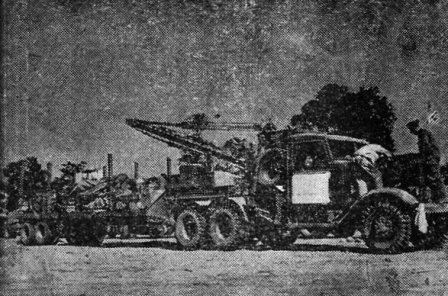 THE LAST HAIRPIN TURN on the Burma Road being negotiated by trucks and jeeps of the famous Quartermaster convoy.
An SOS regulation station was located here under the shadow of Shi Shan (West Mountain).
THE LAST HAIRPIN TURN on the Burma Road being negotiated by trucks and jeeps of the famous Quartermaster convoy.
An SOS regulation station was located here under the shadow of Shi Shan (West Mountain).
|
 TYPICAL CONVOY DRIVER Corp. Richard V. Koenig, Little Rock, Ark., a former truck driver, was right at home in
the cab of the 6 x 6 he piloted across the Himalayan mountains.
TYPICAL CONVOY DRIVER Corp. Richard V. Koenig, Little Rock, Ark., a former truck driver, was right at home in
the cab of the 6 x 6 he piloted across the Himalayan mountains.
|
 THROUGH TUNG MENG (East Gate) and down the main street of Kunming rolled the first vehicles of the convoy which
completed the 6,000 mile journey.
THROUGH TUNG MENG (East Gate) and down the main street of Kunming rolled the first vehicles of the convoy which
completed the 6,000 mile journey.
|
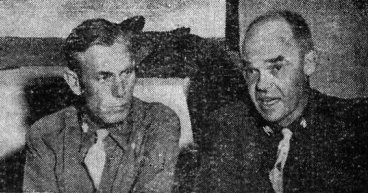 CONVOY CHIEFS Lt. Col. Sterling Apgar, left, Bound Brook, N.J. and Col. Paul R. Guthrie, Denver, Colo., who
with their men, were honored at a dinner at the SOS mess hall in Kunming.
CONVOY CHIEFS Lt. Col. Sterling Apgar, left, Bound Brook, N.J. and Col. Paul R. Guthrie, Denver, Colo., who
with their men, were honored at a dinner at the SOS mess hall in Kunming.
|
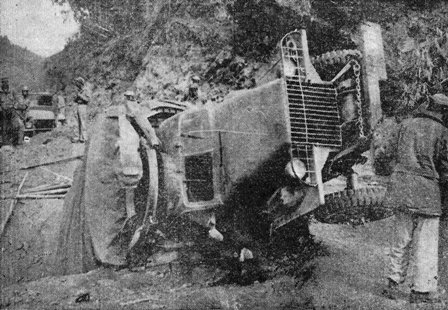 ROAD CAVE IN - This 6 x 6 almost disappeared into the gorge when a section of the road gave way. Quartermaster
convoy mechanics and drivers righted the truck and had it rolling within two hours.
ROAD CAVE IN - This 6 x 6 almost disappeared into the gorge when a section of the road gave way. Quartermaster
convoy mechanics and drivers righted the truck and had it rolling within two hours.
|
WD Announces Discharge System
|
Score Is Temporary; Points And Credits Briefed In Full
WASHINGTON - The War Department last Thursday announced that an interim score of 85 points had been established for the Army Ground, Air and Service Forces male enlisted personnel to be considered eligible for discharge, and the manner in which the points may be acquired.
At the same time the WD announced that the interim score of 85 is temporary, because it will take about six weeks for the Individual Adjustment Service Rating cards to reach Washington from all theaters, but the War Department doesn't want to delay releases until the computations can be completed.
Maj. Gen. William F. Tompkins, Division of the War Department, announced the plan that will control the priority of separation, stating, "It will apply equally to soldiers all over the world and embodies the desires of the soldiers themselves as expressed in polls taken by the War Department."
POINT SYSTEM
The program provides for the issuance of Adjusted Service Ratings Cards to each enlisted man and woman. Separate point totals will be entered on the cards covering the following four factors:
Service Credit - one point for each month of Army service since September 16, 1940.
Overseas Credit - one point for each month served overseas since September 16, 1940.
Combat Credit - five points for the first and each additional award of the following for service performed since September 16, 1940: Medal of Honor, Distinguished Service Cross, Legion of Merit, Silver Star, Distinguished Flying Cross, Soldier's Medal, Bronze Star Medal, Air Medal, Purple Heart and Bronze Service Stars (Battle Participation Stars).
Credit will also be given for the following decorations awarded by the Navy: Navy Cross, Distinguished Service Medal, Legion of Merit, Silver Star Medal, Distinguished Flying Cross, Navy and Marine Corps Medal, Bronze Star Medal, Air Medal and Purple Heart Medal.
Credit will be given for those awards and decorations of foreign countries which may be accepted and worn under the War Department regulations in effect when the Readjustment Regulations were placed in operation.
Parenthood Credit - Twelve points for each dependent child under eighteen years of age up to a limit of three children.
EXCEPTIONS
Men with the highest point totals will become eligible for release from the Army, except where considerations of military necessity make it impossible to let them go until qualified replacements can be obtained.
This exception applies particularly to men possessing special skills required in the war against Japan, and to men in units that will have to move to the Pacific so swiftly that no opportunity is provided for replacing men with high scores until they reach the new theater.
The Army wants to be absolutely certain however that such cases which arise represent true military necessity and not "military convenience." Therefore the various theaters have been instructed to establish a reviewing authority at an appropriate level to consist of selected mature officers who will pass on every case where an individual is to be retained by reason of military necessity.
SYSTEM HAS DESIRED EFFECT
In order to illustrate the fact that the new system of points will actually achieve the desired effect of permitting soldiers who have seen the longest and most arduous service away from home and those with children to leave the Army first, the War Department has issued the following facts:
On the basis of a preliminary survey covering the one-sixth demobilization of the Army, the War Department indicated that all but two percent of the men released will be men who have seen overseas service, and that this two percent will be fathers who have been in the Army a long time.
The significance of these figures will become clearer when it is considered that 68 men out of every 100 now serving in the Army have served overseas, whereas 98 out of every 100 to be returned to civilian life will be overseas veterans.
Men who have been in combat constitute 35 percent of the Army but 73 percent of the men who will get out are men from this group. In short, men with combat experience make up a little over one-third of the Army, but constitute nearly three-quarters of the number to be released.
Fathers represent 19 percent of the Army and 26 percent of the group returning to civilian life. In other words one soldier out of five is a father, but one man in every four to be released will be a father.
CRITICAL SCORE TEMPORARY
After the Adjusted Service Rating Cards have been filled out, the number of soldiers with each point total will be reported to the Adjutant Generals Office in Washington and a certain point total established as critical scores. This critical score represents the minimum number of points with which an enlisted man or woman can be released from the Army.
On the basis of the WD preliminary surveys there is no indication that the interim critical score is higher than the one that will finally be compiled, but when the reports from all the theaters are consolidated the score might possibly be lower.
There will be one critical score for all enlisted men in the Army Ground and Service forces, and another for all men in the Army Air Forces. A third critical score will be established for the WACs. The three critical scores are designed to effect equality of treatment for enlisted personnel in all branches of the service.
The interim score of 85 points has been established pending compilation and all soldiers with 85 or more at present will be considered eligible for release in accordance with the plan and will begin moving to Reception Stations for the determination of their essentiality as soon as practicable. The interim score for the WAC is 44.
NO ACCUMULATION OF POINTS
Only points scored as of Saturday, May 12, 1945, will be taken into consideration in determining the eligibility for release. The only credits which will be given after that date will be for decorations and battle participation stars earned prior to that date. Additional credits will also be given for children born on or before 12 May but whose birth was not known to the father at the time the scores were prepared.
Because of the war needs the initial rate of release will be more rapid among the Ground troops then among those assigned to the Air and Service Forces. However, through transfer of some low score men from the Ground Forces, and new trainees, a proportionate share of men will be released from all three forces as rapidly as practicable.
SAME BASIS FOR OFFICERS
Officers will have an adjusted service rating based on the same multiples as enlisted men. However this will be secondary to the prime requirement of military necessity. This expression as applied to officers, means consideration must be given to an individual based on the need for his specialty, and the availability of assignments which will make best use of his capabilities.
Officers with lengthy overseas service and long and hazardous service in combat will be given special consideration for release. An officer's desire to remain in service at this time will also be another factor to be given consideration. His retention, however, will finally be determined by the War Department, based on the necessity for further utilization of officers of his arm or service.
OTHER RELEASE FACTORS STILL STAND
The carrying out of the program will not affect the continued release of enlisted men over 42 upon application without regard to other factors. The holders of the Congressional Medal of Honor are also eligible for release upon their own request, and married members of the WACs upon their own request, if their husbands have been separated from the Army and returned to civilian life.
RECEPTION STATIONS
When the individuals declared surplus to overseas theaters arrive in the U.S. they will proceed from the ports to Reception Centers close to their home areas. Twenty-two of these reception stations will be placed about the country in order that the Army may bring the individuals as near to their home as possible.
Here is the reception stations those individuals with score equal or above the critical score will be screened once more to determine whether they are essential to the Army as a whole, or nonessential and can therefore be returned to civilian life.
An enlisted man will be held at this point as essential to the Army only if his skill is so important to the Army and so scarce that he cannot be spared. Individuals of this type who have been held will be replaced as rapidly as the Army can train and make available replacements with the proper skills.
Individuals who are found non essential will be immediately transferred to separation centers located at the same post for processing for release from the Army. The complete process in the separation centers will take about 48 hours.
Through these same reception centers pass the individuals returned to the U.S. in units which will be required for continued service against the Japanese. In almost every case these individuals will have scores below the critical score.
They will be brought from the ports to reception centers to get them as close to home as possible, given travel time to and from their homes, plus up to 30 days furlough for rest and recuperation. After that they will report to a designated point where their units to be reformed for continued active service.
New Plan Cancels Rotation System
This new readjustment of personnel plan cancels the old rotation system, according to an official statement issued by the War Department.
The statement said in part: "On the day that the critical scores are announced, rotation in all theaters will be suspended, except for AAF combat crews and other individuals who have been already notified of their selection and are awaiting shipment to the United States."
The statement continued: "Actually, the suspension of rotation will have little effect on the majority of individuals. In the majority of cases those eligible for rotation in the Army as a whole will also have a high score under the readjustment plan."
Army Lists Battle Stars For Credit
WASHINGTON (ANS) - The Battle Participation Stars, which are one of the factors for combat credit under the new Army discharge system, are based on 30 campaigns and battles listed so far by the War Department.
Included are Rome-Arno, Southern France, Germany, Air Offensive against Japan, Naples-Foggia, Burma 1942, China, Aleutian Islands, Air Offensive Europe, Egypt-Lybia, Algeria-French Morocco, Tunisia, Sicily, Bismark Archipelago, Northern France, Central Burma 1945, Ardennes, Central Pacific, Philippine Islands and adjacent waters, Papua, New Guinea, India-Burma, Eastern Mandates, Western Pacific, Philippines, and Luzon.
Mars Hero Gets Posthumous Award
CALCUTTA (ANS) - Lt. Jack Knight of Weatherford, Tex., has been posthumously awarded the Congressional Medal of Honor, the first to be given in the China-Burma-India Theater of operations.
Knight, a member of the Mars Task Force was killed in action on February 2 on the Burma Road, north of Lashio.
Blinded by shrapnel, he regrouped his men after a six-hour fight and personally led an attack against a ring of Japanese pillboxes. He was then knocked down by a grenade but continued to direct the attack, leaning on his elbow. As he started to crawl towards the last pillbox he was killed by a bullet.
After Knight's first wound his brother, Sgt. Curtis Knight, took command but he was immediately wounded and carried to the rear.
|
PILOT PRAISES PLANE THAT "COULDN'T FLY"
HQ. WEST CHINA RAIDERS - "Somebody back home did a damn good job of building an airplane!"
That was the comment of Thunderbolt pilot Capt. Thomas D. Harrison, Clovis, N.M., when he was carried into his forward fighter base after a 140-mile flight in a plane that "couldn't fly" and a crash landing in "impossible terrain."
The captain was strafing warehouses and supply dumps in the Laohokow battle area, flying "on the deck" and ignoring the string of holes he was picking up in his wings and fuselage from small arms fire. On his third pass, a Jap got in a lucky shot and knocked out the plane's fuel system.
At the same time, a bullet clipped his parachute harness in two and another buried itself in the pack, rendering the chute useless. And, just to make the job thorough, one Jap bullet was aimed to kill him. Miracle number one happened along to deflect it on a harness buckle.
With the oil rapidly draining out of the P-47's engine, Captain Harrison began to look for a spot to crash-land. But the terrain was mountainous and a forced landing, he saw immediately, would be suicide.
"on top of that," he commented, "I was many miles from base and between me and that field, a good spot where I could possibly crash-land and live was a sand bar - 140 miles away!"
With his heart in his mouth and his eyes glued to the oil pressure gauge he headed toward home, climbing slowly until he had reached nearly 10,000 feet. For half an hour his P-47 wobbled along with oil spewing out of the engine. Finally, the needle dropped to zero and stayed there.
"After that, it just wasn't supposed to fly," the captain explained. "But it did fly. That engine kept turning over without any oil in it for 19 minutes and when it finally stopped doing the impossible and froze solid, I was over the sandbar."
Capt. Harrison has spent a year in China as a combat pilot in the Thunder-Dragons group of Brig. Gen. Russell E. Randall's West China Raiders.
MEDICS NAME POISON-EATING DOG 'DIAREA'
1340th ATC BASE, KUNMING - Medical officers here came to the rescue of their poisoned pup recently when the dispensary pet ate a double order of rat poison.
The dog, of breeds too numerous to mention, followed Sgt. Harry R. Douglas to the dispensary one day and they adopted him. He was only about six weeks old at the time and looked a little undernourished, so the boys in the dispensary fed him and cleaned him up until he was a respectable looking pup.
The dog went unnamed until the day he ate the rat poison. As an antidote for the poison, the medical men gave the pup a large dose of mineral oil and epsom salts. The dog was busy for the next few days, and a rumor around the dispensary said that there were three dogs helping him dig holes, and three more covering them up.
That's the way that the dog got the unusual name of Diarea. He's O.K. now and can be seen every day riding beside Sgt. Douglas in the ambulance.
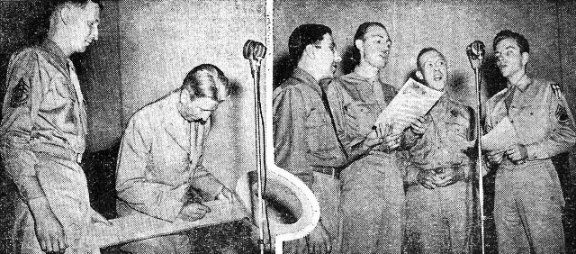 LT. GEN. A. C. WEDEMEYER autographs a giant wooden key at the request of T/Sgt. Paul Schommer, Chadron, Neb.,
chairman of the enlisted mens committee, Hq., USF, CT, at the dedication of the Tibbets Memorial Center in Chungking.
The center, a combination theater and recreation hall, was opened early this month. The key was presented by Gen.
Wedemeyer as symbolic of the fact that the new building will open the doors to entertainment to all men stationed at
the China Theater headquarters.
The "Chungking Serenaders" added a musical touch to the dedication of Tibbets Memorial Center. Serenaders
are, left to right, Chief Yeoman William Hahn, Bradford, Pa.; Sgt. Perry Sewell, Swainsboro, N.C.; Pvt. Joseph B. Hudson,
Jr., Camden, N.J., and S/Sgt. Marshal Cleaver, Trevose, Pa.
LT. GEN. A. C. WEDEMEYER autographs a giant wooden key at the request of T/Sgt. Paul Schommer, Chadron, Neb.,
chairman of the enlisted mens committee, Hq., USF, CT, at the dedication of the Tibbets Memorial Center in Chungking.
The center, a combination theater and recreation hall, was opened early this month. The key was presented by Gen.
Wedemeyer as symbolic of the fact that the new building will open the doors to entertainment to all men stationed at
the China Theater headquarters.
The "Chungking Serenaders" added a musical touch to the dedication of Tibbets Memorial Center. Serenaders
are, left to right, Chief Yeoman William Hahn, Bradford, Pa.; Sgt. Perry Sewell, Swainsboro, N.C.; Pvt. Joseph B. Hudson,
Jr., Camden, N.J., and S/Sgt. Marshal Cleaver, Trevose, Pa.
|
|
|
Sequel To The Secret In the dark of midnight While the ground crew hits the hay The pilot sweats out thunderstorms And earns his flying pay And when the going's toughest And the ice is on the wing The pilot thanks his lucky stars That the ground crew's engines sing But when the crosses, row by row, Grow longer every day. The ground crew works, and sleeps and eats And sweats rotation day. - J.H.D. and A.C.K. |
Chaplain's Daughter, Age 5, Packs Personality Aplenty
KUNMING - Jeanette is one of the best-known Americans in this area.
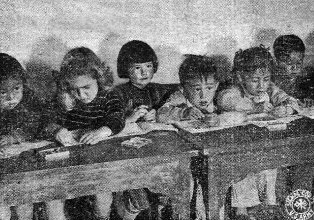
|
She is the youngest of the Blackstone trio of children and is just five, but she is a loyal and busy aide for her father, Chaplain William Blackstone, former Presbyterian minister now serving with U.S. Forces here.
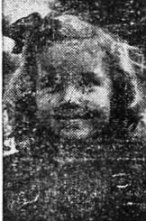
|
Jeanette was born in Shanghai, her sister, Margaret, 9, was born in Chen-hsien and her brother, Bobby, 12, arrived in Hengyang.
For the last year they have been living in Kunming. They left Hengyang just before the Japs took over there so have had some experience with bombings, refugee trains, and such inconveniences of war as are common in China. The Blackstones claim Pasadena, Calif., as home.
Jeanette accompanies her father on many of his journeys to hospitals, to call on GIs at their barracks, and to meetings of various kinds. The trio often sings for church services, too. Their mother, who taught them their music, plays the piano for them.
Many a GI in China has partaken of the hospitality of the Blackstone home. The children, while interested in their Chinese playmates and able to speak and understand Chinese, are very much American in their general outlook on life and remind soldiers in this strange land of folks at home. They are real morale builders.
Jeanette and her brother and sister are quite nonchalant about their social work which they enjoy.
'Tigers' Top ASC Officer Ten, 4-2
AIR BASE, APO 627 - Coming from behind with two runs to tie the score in the seventh inning and then going on to win with two more in the eighth, the "Flying Tigers" chewed out a 4-2 triumph over a strong ASC officers ten in a softball game Sunday at APO 627.
Behind the brilliant pitching of Capt. Behrens, who fanned 18 "Tigers" over the eight inning route, the CASC crew had jumped out to a 2-0 lead in the lower half of the third inning, when Major Miller walked, Yerman belted a hit to deep left field and both scored when Martins throw in bounded away from shortstop Johnny Horne. From that point on Maj. Gen. Chennault, hurling for the "Tigers," was nearly untouchable, allowing only one hit the rest of the way.
Coming up to the seventh Behrens had fanned 13 and allowed two safeties. Then in true Merriwell fashion the "Tigers" tied the score. With two away Lt. Kneibel, Tiger backstop, kept hope alive by lining a sharp single. With the outfield drawn over to left Major Smith blasted Berhen's first pitch down the right field line for a home run to knot the count.
Another circuit clout won the contest for the Tigers' in the eighth, when, with two away and Whitney on first by virtue of a walk, Capt. Kreiger, batting from the port side, poled a long drive down the left field line and scored before the outfielder even touched the ball.
ATC Sweeps Track Meet At Yunnan Stadium Last Sunday
Displaying a complete mastery in the running events and gaining valuable added markers in the field events, the ATC track team ran away with the All-American Track and Field Meet at the Provincial Stadium Sunday, May 13, piling up a total of 84½ points over their nearest competitors, a Weather outfit, that compiled 19½ points.
Three new track stars appeared on the local track horizons, and three meet records were broken on the cinder paths, which the early morning light rain had left in almost perfect running condition.
Capt. E. Kollar, ATC, one of the double winners of the day, lopped five seconds off the old meet mail record when he pounded home in 4:54.3 with a good 75 yard lead over Pfc. John J. Lynch, ATC, who had set the old record in the previous meet.
Another ATC man, Pvt. Arvel Goodman, former University of Kentucky sprint star, clipped a tenth of a second off the old 100-yard dash standard when he breasted the tape in 10.6 seconds in the sprint classic. In the rest of a busy running afternoon he copped second places in the 200-yard dash and the 220-yard low hurdles.
The other double winner in the afternoon's activity was Capt. Dick Ganslen, former Columbia University all-around athlete, who was in a class all by himself in the pole vault, scaling 13 feet for first place. He also took first in the broad jump with a leap of 19 feet, 9½ inches. Both of these marks are below his usual standard due to lack of practice.
Lt. William Taylor, 14th Air Force Hq., a newcomer to the track meets here, broke the former high jump mark for the meet soaring over the bar at 5 feet, 11½ inches. The former University of California field man, used to sniffing the rarified are of over six feet was disappointed with the mark and promises to set a higher mark at
 the Allied Meet Sunday, May 20.
the Allied Meet Sunday, May 20.
S/Sgt. Mel Macceau, former Marquette University football star and center on the AACS quintet that won the recent All-China basketball championship, repeated last years win in the shot-put event heaving the iron ball 48 feet, 6½ inches.
The winners of Sundays events, bolstered by some of the runners-up in the various track and field events will compose the American team that is to run against a picked Chinese team of University stars in the Allied Track and Field Meet at the same Stadium this Sunday, May 20.
Sunday's track carnival, and the Allied Meet this Sunday, are sponsored by the 14th Air Force Base Special Service, under the direction of Pfc. John Adrich, former Athletic Director at St. Johns College in Minnesota, and with the co-operation of both American and Chinese officials who acted as field judges and timers in the smoothly run events.
China Track Meet Victors . . .
 LEFT: S/Sgt. Mel Macceau, Milwaukee, Wis., threw the shot 48'6½" to win the event for AACS and four cans of beer
for himself. SECOND FROM LEFT: Capt. Edward G. Kollar, Passaic, N.J. winning the mile run for ATC in 4:54.3. CENTER:
Breaking the track record of 5' 10", Lt. William H. Taylor, Fullerton, Cal., clears 5' 11½" to win the high
jump for the Flying Tigers. SECOND FROM RIGHT: Pvt. Arvel W. Goodwin, Cincinnati, noses out his ATC teammate, Pfc.
Lewis Bass, to win the 100-yard dash in 10.6. Goodman was on the University of Kentucky track team. RIGHT: Sgt. James
Jackson, Petersburg, Ind., clears the last hurdle before winning the 220 low hurdle event for the ATC team.
LEFT: S/Sgt. Mel Macceau, Milwaukee, Wis., threw the shot 48'6½" to win the event for AACS and four cans of beer
for himself. SECOND FROM LEFT: Capt. Edward G. Kollar, Passaic, N.J. winning the mile run for ATC in 4:54.3. CENTER:
Breaking the track record of 5' 10", Lt. William H. Taylor, Fullerton, Cal., clears 5' 11½" to win the high
jump for the Flying Tigers. SECOND FROM RIGHT: Pvt. Arvel W. Goodwin, Cincinnati, noses out his ATC teammate, Pfc.
Lewis Bass, to win the 100-yard dash in 10.6. Goodman was on the University of Kentucky track team. RIGHT: Sgt. James
Jackson, Petersburg, Ind., clears the last hurdle before winning the 220 low hurdle event for the ATC team.
Oldtimers Report Early China Loops
Oops! Looks like the sports department put itself out on the limb with the statement, a wild one as we look back on it, in the May 4 issue that the "first organized baseball league in the history of China got underway."
It looks like we should have said "the first in Yunnan Province" or possibly narrowed it even further and said the first "local" league, because irate letters have been coming in from old China hands telling us about earlier leagues.
It seems that organized leagues were in existence in China 20 and possibly 25 years ago. At least 20 years ago, anyway, it appears that there was an organized baseball circuit of American and Japanese teams in North China.
Teams usually in the Loop were from the U.S. Army in Tientain, the U.S. Marines from Peiping, American business and college men at Tientsin, and Japanese business and collegians from Tientsin. Besides the regular league games, these teams frequently played games with other nines from the Philippine Islands, Guam and Hawaii.
Each year at Tientsin, we are informed, there was a baseball game between the British and American officers, followed the next week by a cricket match between the same groups.
Lt. Gen. Wedemeyer, now commanding general of the China Theater, used to frequently act as batting practice pitcher for the Tientsin Army team, and Maj. Gen. R. B. McClure, commanding general of the CCC, is said to have played a smooth game around first base for the same team in 1929, '30 and '31.
Another rumor has reached the sports desk to the effect that there was also a baseball league operating around Shanghai during peacetime. Possibly some of the old-timers could straighten us out on that matter.
Bulldogs, Orioles And CCC Win Opening Baseball Games
Playing at two fields, the opening day baseball games of the American Baseball League, Sunday, May 13, produced the usual inaugural games assortment of free-hitting contests and well-pitched games, as the CCC Club 11 outlasted the CTC Snipers 16-15 and the SOS Bulldogs nipped the China Yanks 3-1 at the Kunming Athletic Field, and the Orioles battered the Mustangs 9-3 at the Post Office diamond.
In the best pitched game of the day, Hardy, chucker for the Bulldogs, completely subdued the China Yanks over the nine inning route facing only 28 batters, fanning 16, and allowing only three hits. The lone run scored against him was Colasacco's home run in the second inning.
Palumbo pitched steadily for the Yanks, but weakened momentarily in the fourth inning when the Bulldogs bunched four of their five hits. Brown, Staley and Wilson singled in succession. Hardy was safe on Claxton's error, and Hutton climaxed the rally with the fourth hit of the inning to drive in the third run.
Hits were a dime-a-dozen in the other game at the same field as the CCC and CTC nines battered out 29 base hits, including several circuit clouts. The CCC club, behind 11-3 in the fifth inning, put together 13 runs in
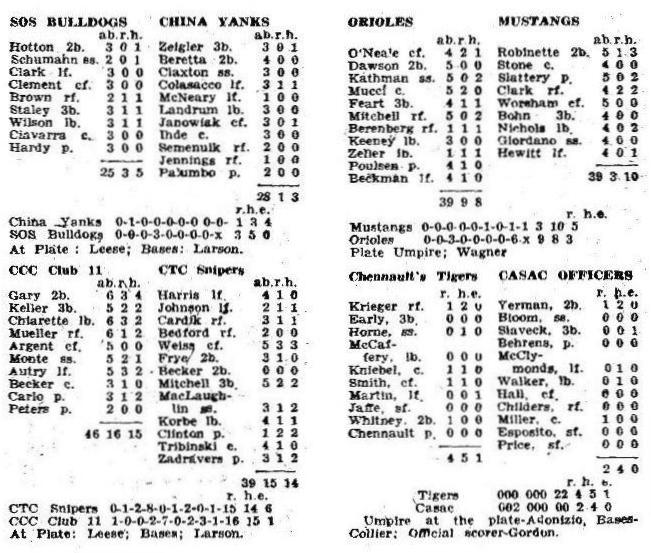 the last five stanzas, climaxing the surge with a run in the lower half of the ninth, after CTC had tied the score,
to win the free-scoring contest 16-15.
the last five stanzas, climaxing the surge with a run in the lower half of the ninth, after CTC had tied the score,
to win the free-scoring contest 16-15.
Gary, the CCC second sacker, led the winners with four hits, including a home run, in six appearances at the plate, while Weiss with 3 for 5, and also a circuit smash, topped the losers.
In the only game at the Post Office diamond, the Ordnance Orioles put together two big innings to down the Mustangs by a 9-3 margin. Pitching steadily all the way, Poulsen, the Oriole hurler, though nicked for ten hits, tightened up when the going got rough, striking out nine Mustangs in the clutch. Two of the Mustangs' runs were accounted for by home runs by Robinson and Clark.
After two scoreless innings the Orioles tallied in the third on two walks, errors by Bohn and Giordano, and O'Neal's single for three runs. They went scoreless until the eighth, when, with the score 3-2 in their favor, they belted home six markers to ice the game. Two walks, an error by Nichols, and hits by Kathman, Peart, Berenbeg and Zeller accounted for the rally before Mucci, up for his second time, ended the inning.
The other schedules game at the Post Office field was not played due to the fact that the Rinkydinks failed to show up for their game with the ATC Commandos at the appointed time.
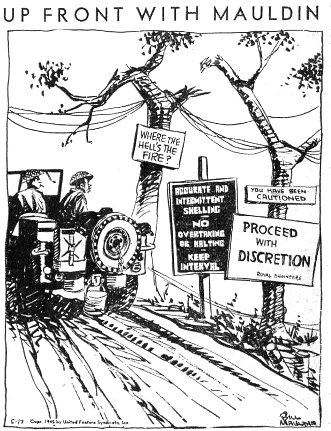
|
Five-Man Art Exhibit
Held At Rear Echelon
REAR ECHELON HQ., USF CT - As the first in a series of art exhibits to enable officers and enlisted men of this headquarters an opportunity to display their artistic talents, the Red Cross "Alibi" Club last Sunday held a showing of the water colors and black-and-white washes of five enlisted men.
The paintings, the accumulation of several months of work, were the efforts of Sgts. James Sodon, theater signal office, Bob Huntington and Russell Swan, theater engineer office, S/Sgt. Roy Schatt, special service, and S/Sgt. Gordon Billings, Rear Echelon public relations.
Huntington, who studied art at the Albright School of Fine Arts and Buffalo University, New York, displayed several fine pieces, varying from the impressionistic to the realistic school.
Swan, who studied under the well-known artist, T/Sgt. James M. Zornes, who is now a War Department soldier-painter, at Otis Art Institute in Loa Angeles, has painted as a hobby since 1932.
S/Sgt. Schatt, New York City, displayed several exceptional paintings. He has had broad training, specializing in commercial work. He has painted for Warner Brothers in Washington, D.C., and the U.S. Department of Agriculture.
Gordon Billings, who has been painting only since January of this year, displayed some fine work, showing much promise of future excellence.
James Sodon displayed several black-and-whites washes.
The "Sampan" and "Rest Camp" by Swan, "Village" by Huntington, "Ching Pi Lu Funeral" by Schatt, and "Chinese Pavilion" by Billings, drew the most comment and study.
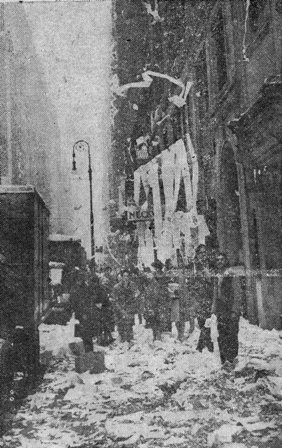 DON BARCLAY, against a backdrop of famous men, sketched Pvt. Arthur L. Dixon of Los Angeles. Currently touring
China for the second time, Hollywood cartoonist Barclay has sketched soldiers all over the world. He and Dixon were
friends in civilian life. The GI formerly was a technician for a Hollywood studio.
DON BARCLAY, against a backdrop of famous men, sketched Pvt. Arthur L. Dixon of Los Angeles. Currently touring
China for the second time, Hollywood cartoonist Barclay has sketched soldiers all over the world. He and Dixon were
friends in civilian life. The GI formerly was a technician for a Hollywood studio.
|
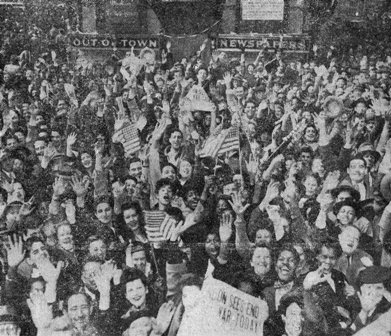 QUIZ KIDDER - Leon Henderson, former OPA chief, now in China to survey problems of war-time inflation for the
Chinese government, cracks back at a GI questioner at an open forum held for enlisted men at the Red Cross club in
Chungking.
QUIZ KIDDER - Leon Henderson, former OPA chief, now in China to survey problems of war-time inflation for the
Chinese government, cracks back at a GI questioner at an open forum held for enlisted men at the Red Cross club in
Chungking.
|
 RUBBING IT IN - because Sgt. Edwin R. Snider, Coke, Va., made a wager with Corp. Alexander W. Vanderslice,
Richton, Miss., that the war in Europe would not be over by June 1 he was forced to pay off. The agreement was that
the winner would select the manner in which the bet would be settled. When V-E Day was declared on May 8, Vanderslice
decided that a mud-pack facial with the good earth of China, wet down to make a fine, gooey substance, would do the
trick. Above, Vanderslice exacts his winnings by applying the mud-pack to Snider's face. Fellow members of the 14th
Air Force motor pool detachment look on, left to right, T/Sgt. Charles M. Bowman, Ann Arbor, Mich., Corp. Charles W.
Vale, Bicknell, Ind., and Corp. James D. Bell, Hinesburg, Vt.
RUBBING IT IN - because Sgt. Edwin R. Snider, Coke, Va., made a wager with Corp. Alexander W. Vanderslice,
Richton, Miss., that the war in Europe would not be over by June 1 he was forced to pay off. The agreement was that
the winner would select the manner in which the bet would be settled. When V-E Day was declared on May 8, Vanderslice
decided that a mud-pack facial with the good earth of China, wet down to make a fine, gooey substance, would do the
trick. Above, Vanderslice exacts his winnings by applying the mud-pack to Snider's face. Fellow members of the 14th
Air Force motor pool detachment look on, left to right, T/Sgt. Charles M. Bowman, Ann Arbor, Mich., Corp. Charles W.
Vale, Bicknell, Ind., and Corp. James D. Bell, Hinesburg, Vt.
|
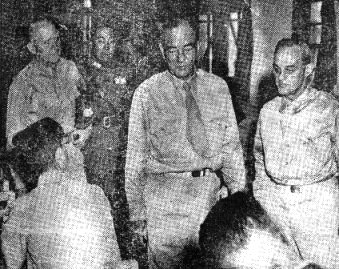 DISTINGUISHED VISITOR - Lt. Gen. Dan I. Sultan, commanding general, I-B Theater, visiting a class at the Command
and General Staff School of the Chinese Training Center. Gen. Sultan praised the work of the Chinese troops who served
under him in the Burma campaign. Left to right, Col. Clinton McClure, chief of staff, CTC; Lt. Gen. Chao Chia Chiang,
chief of staff, Chinese 5th Army; Lt. Gen. Sultan and Col. Edward D. Sirois, executive officer, Command and General
Staff School.
DISTINGUISHED VISITOR - Lt. Gen. Dan I. Sultan, commanding general, I-B Theater, visiting a class at the Command
and General Staff School of the Chinese Training Center. Gen. Sultan praised the work of the Chinese troops who served
under him in the Burma campaign. Left to right, Col. Clinton McClure, chief of staff, CTC; Lt. Gen. Chao Chia Chiang,
chief of staff, Chinese 5th Army; Lt. Gen. Sultan and Col. Edward D. Sirois, executive officer, Command and General
Staff School.
|
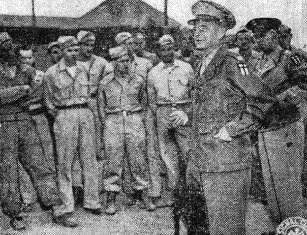 BRIG. GEN. DOUGLAS L. WEART, China Theater deputy chief of staff, addressing a group of SOS personnel before
their departure for India where they will join a convoy back to China over the Stilwell Road. Maj. Gen. G. X. Cheves,
commanding general, SOS, extreme right, looks on. Groups of picked men from SOS and other organizations are sent to
India to bring back vehicles and vital supplies to China's fighting forces.
BRIG. GEN. DOUGLAS L. WEART, China Theater deputy chief of staff, addressing a group of SOS personnel before
their departure for India where they will join a convoy back to China over the Stilwell Road. Maj. Gen. G. X. Cheves,
commanding general, SOS, extreme right, looks on. Groups of picked men from SOS and other organizations are sent to
India to bring back vehicles and vital supplies to China's fighting forces.
|
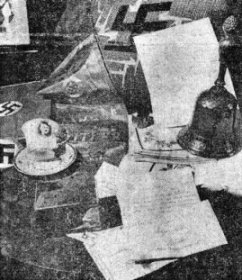 EGOTISTICAL EVIDENCE - Proof of Adolf Hitler's self-esteem is shown in these personal effects found in his
various residences. His stationery, ceremonial ribbon, and even his cup bears either his name or portrait. The swastika,
symbol of cruelty, also is prominently displayed on all belongings of the fallen fuehrer. Note set of false teeth.
EGOTISTICAL EVIDENCE - Proof of Adolf Hitler's self-esteem is shown in these personal effects found in his
various residences. His stationery, ceremonial ribbon, and even his cup bears either his name or portrait. The swastika,
symbol of cruelty, also is prominently displayed on all belongings of the fallen fuehrer. Note set of false teeth.
|
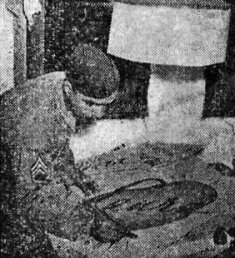 PROMOTION DEPT. - S/Sgt. Roy Schatt, New York City, applying the brush to one of the posters he painted as a
special service stunt in connection with the showing of the 20th Century-Fox movie, "Lura" in Kunming.
PROMOTION DEPT. - S/Sgt. Roy Schatt, New York City, applying the brush to one of the posters he painted as a
special service stunt in connection with the showing of the 20th Century-Fox movie, "Lura" in Kunming.
|
The CHINA LANTERN is the weekly newspaper of the United States Forces in the China Theater and is published by Lt. Lester H. Geiss, Editor-In-Chief, for military personnel only. T/Sgt. Harry Purcell, Managing Editor; Sgt. Maurice Pernod, Production Chief. Editorial offices: Hqrs., SOS, China Theater, Kunming, China, and Hqrs., SOS, Calcutta, India. Printed by Ajit Kumar Sinba at the "Amrita Bazar Patrika" Press.

MAY 18, 1945
Original issue of The China Lantern shared by Hal Baker
Copyright © 2008 Carl Warren Weidenburner
TOP OF PAGE PRINT THIS PAGE ABOUT THIS PAGE
SEND COMMENTS CLOSE THIS WINDOW
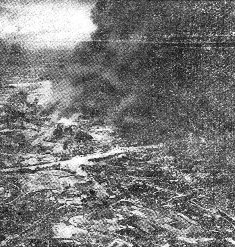 PROCESSING OF PAOCHING on the Tzu by more than 100 heavy and medium bombers of the Fourteenth Air Force, plus
fighters, on May 9 plastered the Japanese supply funnel to the Hunan front with more 100 tons of bombs of which a
quarter were concentrated firebombs which turned the 138-acre city into a mass of flames.
The above photo shows flames sweeping both sections of the city connected by a road bridge across the tributary to the
Tzu and, left center, the Paoching air strip, bombed out of operational value by the Fourteenth since the Japs took the
town in the Siang drive last July.
PROCESSING OF PAOCHING on the Tzu by more than 100 heavy and medium bombers of the Fourteenth Air Force, plus
fighters, on May 9 plastered the Japanese supply funnel to the Hunan front with more 100 tons of bombs of which a
quarter were concentrated firebombs which turned the 138-acre city into a mass of flames.
The above photo shows flames sweeping both sections of the city connected by a road bridge across the tributary to the
Tzu and, left center, the Paoching air strip, bombed out of operational value by the Fourteenth since the Japs took the
town in the Siang drive last July.
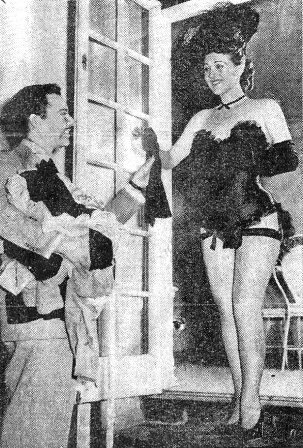 GYPSY ROSE LEE set the ball rolling for the United Nations clothing collection for Europe's needy recently by
contributing a generous supply. At the receiving end is Jerry Wayne, Blue Network singing star.
GYPSY ROSE LEE set the ball rolling for the United Nations clothing collection for Europe's needy recently by
contributing a generous supply. At the receiving end is Jerry Wayne, Blue Network singing star.
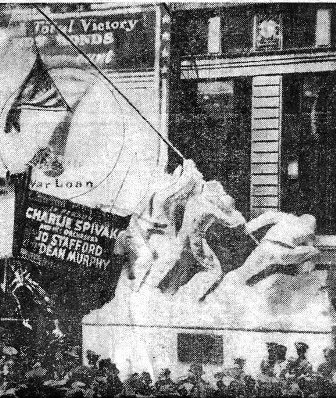 LEST WE FORGET - The Seventh War Loan Drive was opened in New York by the unveiling of a statue of U.S. Marines
raising the flag on Iwo Jima. The scene was taken from a photograph (China Lantern, March 9) by AP photographer Joe
Rosenthal who struggled to the top of Mt. Suribachi with these men. The flag in the above photograph is at half mast
in mourning for the late Pres. Roosevelt.
LEST WE FORGET - The Seventh War Loan Drive was opened in New York by the unveiling of a statue of U.S. Marines
raising the flag on Iwo Jima. The scene was taken from a photograph (China Lantern, March 9) by AP photographer Joe
Rosenthal who struggled to the top of Mt. Suribachi with these men. The flag in the above photograph is at half mast
in mourning for the late Pres. Roosevelt.


